A Survey on Optimization Techniques Applied to Magnetic Field Mitigation in Power Systems
Abstract
:1. Introduction
2. Mitigation of Low-Frequency Magnetic Fields
2.1. Intrinsic Techniques
- Layout and compaction [13]: It is well-know that, when the relative positions of the conductors are rearranged (layout), for example from linear to equilateral triangle disposition, the MF decays faster as the distance to conductors increases (Figure 1). A further MF reduction can be obtained by reducing the phase-to-phase clearance (compaction). For example, by installing compactors along overhead line spans (realized through rod insulators forming equilateral triangles), a 56% reduction of the maximum ground-level MF is achievable, in comparison to an overhead transmission line realized with compacted towers (the solution that, at present, minimizes the magnetic field without compactors) [14]. However, this solution also entails a new problem, which includes higher voltage gradients on conductors and insulators, resulting in higher audible noise, radio interference, and increased hardware corona [15,16,17,18]. Additionally, the mitigation achieved can be limited, especially in UPC, where the current rating (ampacity) may be affected by these techniques [19].
- Distance management [13]: Since the intensity of a MF decreases naturally, as a function of distance from the source, it is possible to achieve the appropriate reduced level of MF by simply increasing this distance of separation from the sources (Figure 2). This solution is limited by technical constraints (maximum height for OHL or maximum possible depth for UPC, for example).
- Phase cancellation [22]: Unlike in the phase splitting method, in the phase cancellation method the phases are just rearranged accordingly into an existing configuration. As no new material has to be added, this method is cost effective. This technique is only interesting in the case of more than one circuit. Thus, a representative phase cancellation solution is the low reactance configuration in a double circuit line (Figure 4). The greatest effectiveness of this method is limited almost exclusively to super-bundle double circuit vertical configurations, where the higher and lower phases are interchanged in the second circuit.
2.2. Extrinsic Techniques
- Passive techniques [23,24,25]: In this case, the MF mitigation is obtained because the mitigation system acts in response to the MF generated by the source. For example, a typical situation is when currents are induced in these elements due to Faraday’s Law, which, in turn, generate a new MF that partially cancels the one from the source. Typical mitigation solutions in this group are passive loops [23,24] (Figure 5a) and conductive shields [25] (Figure 5b). Another case is when ferromagnetic materials are used in the mitigation system, since they have the property to attract and trap the MF flux lines thanks to their high permeability. This way, the MF flux lines are moved away from the region to be protected, resulting in a MF mitigation in that area. A good example is the use of ferromagnetic shields [25] (Figure 5c).
- Active techniques [26]: In contrast to previous solutions, active techniques require the use of external power sources to inject appropriate currents (magnitude and phase) in the mitigation system to provide the required mitigation effect (Figure 5d), and, as such, are able to provide a much higher mitigation reduction [26,27,28,29,30]. This is usually used in the so-called active loops. Nonetheless, this requires a more complex mitigation system, as it is necessary to install expensive equipment apart from MF sensors, such as the power sources, and a monitoring system to continuously adjust the injected current to achieve the required mitigation at any time [26,27,30]. All this makes this solution much more expensive than passive ones.
3. Optimization Applied to Intrinsic Techniques
3.1. Conductor Arrangement
3.1.1. Overhead Transmission Lines
3.1.2. Underground Power Lines
3.1.3. Substations
- -
- Preventing useless separation between conductors of different phases;
- -
- Using plaited conductors, with all four conductors, as often as possible;
- -
- Minimizing the length of the cables within the substation;
- -
- Possibly using a compact busbar system, if available, between the transformer and the main LV switchboard.
4. Optimization Applied to Extrinsic Techniques
4.1. Passive Loops
4.2. Active Loops
4.3. Passive Shields
5. Conclusions
Author Contributions
Funding
Conflicts of Interest
References
- WHO/IARC. Monograph 80: Non-Ionising Radiation, Static and Extremely Low-Fequency Electric and Magnetic Fields; WHO/IARC: Lyon, France, 2002; Volume 80. [Google Scholar]
- Rao, S.; Sathyanarayanan, A.; Nandwani, U. EMI problems for medical devices. In Proceedings of the International Conference on Electromagnetic Interference and Compatibility, Bangalore, India, 23 February 2002; IEEE: New Delhi, India, 1999; pp. 21–24. [Google Scholar]
- Shwehdi, M.H. A practical study of an electromagnetic interference (EMI) problem from Saudi Arabia. In Proceedings of the Large Engineering Systems Conference on Power Engineering (IEEE Cat. No.04EX819), Halifax, NS, Canada, 28–30 July 2004; pp. 162–169. [Google Scholar]
- Bontá, D.M.; Director, D.; Richard Neutra, R.; Vincent DelPizzo, D.; Geraldine Lee, G.M.; Lee, S.; Shen Liu, K.; Shaw, G.; Smith, D.; Marilyn Underwood, D.C.; et al. An Evaluation of the Possible Risks from Electric and Magnetic Fields (EMFS) from Power Lines, Internal Wiring, Electrical Occupations, and Appliances; California Department of Industrial Relations: Oakland, CA, USA, 2002.
- Van Loock, W. Elementary effects in humans exposed to electromagnetic fields and radiation. In Proceedings of the IEEE 2009 5th Asia-Pacific Conference on Environmental Electromagnetics, Xian, China, 16–20 September 2009; pp. 221–224. [Google Scholar]
- Florea, G.A.; Dinca, A.; Gal, S.I.A. An original approach to the biological impact of the low frequency electromagnetic fields and proofed means of mitigation. In Proceedings of the 2009 IEEE Bucharest PowerTech, Bucharest, Romania, 28 June–2 July 2009; pp. 1–8. [Google Scholar]
- ICNIRP (International Commission on Non-Ionizing Radiation Protection). Guidelines for Limiting Exposure to Time-Varying Electric and Magnetic Fields (1 Hz to 100 kHz). Health Phys. 2010, 99, 818–836. [Google Scholar] [CrossRef]
- IEEE PC95.1 Draft Standard for Safety Levels with Respect to Human Exposure to Electric, Magnetic and Electromagnetic Fields, 0 Hz to 300 GHz; IEEE: Piscataway, NJ, USA, 2018.
- Amoon, A.T.; Crespi, C.M.; Ahlbom, A.; Bhatnagar, M.; Bray, I.; Bunch, K.J.; Clavel, J.; Feychting, M.; Hémon, D.; Johansen, C.; et al. Proximity to overhead power lines and childhood leukaemia: An international pooled analysis. Br. J. Cancer 2018, 119, 364–373. [Google Scholar] [CrossRef] [PubMed]
- Hossam-Eldin, A.; Youssef, K.; Karawia, H. Measurements and evaluation of adverse health effects of electromagnetic fields from low voltage equipments. In Proceedings of the IEEE 2008 12th International Middle-East Power System Conference, Aswan, Egypt, 12–15 March 2008; pp. 436–440. [Google Scholar]
- Swanson, J. EMF Exposure Standards Applicable in Europe and Elsewhere: Environment & Society Working Group; Connecticut Siting Council: New Britain, CT, USA, 2006.
- Hernández Jiménez, V.J.; Castronuovo, E.D.; Sánchez, I. Optimal statistical calculation of power cables disposition in tunnels, for reducing magnetic fields and costs. Int. J. Electr. Power Energy Syst. 2018, 103, 360–368. [Google Scholar] [CrossRef]
- CIGRÉ Working Group C4.204. Mitigation Techniques of Power-Frequency Magnetic Fields Originated from Electric Power Systems. CIGRÉ Technical Brochure; CIGRÉ: Paris, France, August 2009; ISBN 978-2-85873-060-5. [Google Scholar]
- Bignucolo, F.; Coppo, M.; Savio, A.; Turri, R. Use of rod compactors for high voltage overhead power lines magnetic field mitigation. Energies 2017, 10, 1381. [Google Scholar] [CrossRef]
- Ranković, A. Novel multi-objective optimization method of electric and magnetic field emissions from double-circuit overhead power line. Int. Trans. Electr. Energy Syst. 2017, 27, e2243. [Google Scholar] [CrossRef]
- Hedtke, S.; Pfeiffer, M.; Franck, C.M.; Zaffanella, L.; Chan, J.; Bell, J. Audible noise of hybrid AC / DC overhead lines: Comparison of different prediction methods and conductor arrangements. Epri’s High-Volt. Direct Curr. Flex. Ac Transm. Syst. Conf. 2015, 1, 1–8. [Google Scholar]
- Electric Power Research Institute. EPRI Transmission Line Reference Book: 115–345-kV Compact Line Design: The “Blue Book”; EPRI: Palo Alta, CA, USA, 2008. [Google Scholar]
- Straumann, U.; Straumann, U.; Franck, C.M. Discussion of Converting a Double-Circuit AC Overhead Line to an AC/DC Hybrid Line with Regard to Audible Noise; CIGRÉ: Paris, France, 2011. [Google Scholar]
- CIGRÉ Working Group B1.23. Impact of EMF on Current Ratings and Cable Systems; CIGRÉ Technical Brochure; CIGRÉ: Paris, France, 2013; ISBN 978-2-85873-254-8. [Google Scholar]
- Cruz Romero, P.; Izquierdo Mitchell, C.; Burgos Payan, M. Optimal split-phase configurations. In Proceedings of the 2001 IEEE Porto Power Tech Proceedings (Cat. No.01EX502), Porto, Portugal, 10–13 September 2001; Volume 3, p. 5. [Google Scholar] [CrossRef]
- Pettersson, P. Principles in transmission line magnetic field reduction. IEEE Trans. Power Deliv. 1996, 11, 1587–1593. [Google Scholar] [CrossRef]
- Dawoud, M.M.; Habiballah, I.O.; Farag, A.S.; Firoz, A. Magnetic field management techniques in transmission underground cables. Electr. Power Syst. Res. 1999, 48, 177–192. [Google Scholar] [CrossRef]
- Shperling, B.; Menemenlis-Hopkins, L.; Fardanesh, B.; Clairmont, B.; Child, D. Reduction of magnetic fields from transmission lines using passive loops. In Proceedings of the CIGRÉ Session, Paris, France, 25–31 August 1996; pp. 36–103. [Google Scholar]
- Yamazaki, K.; Kawamoto, T.; Fujinami, H. Requirements for power line magnetic field mitigation using a passive loop conductor. IEEE Trans. Power Deliv. 2000, 15, 646–651. [Google Scholar] [CrossRef]
- Farag, A.S.; Dawoud, M.M.; Habiballah, I.O. Implementation of shielding principles for magnetic field management of power cables. Electr. Power Syst. Res. 2002, 48, 193–209. [Google Scholar] [CrossRef]
- Reta-Hernández, M.; Karady, G.G. Attenuation of low frequency magnetic fields using active shielding. Electr. Power Syst. Res. 1998, 45, 57–63. [Google Scholar] [CrossRef]
- Cruz Romero, P.; Izquierdo, C.; Burgos, M.; Ferrer, L.F.; Soto, F.; LLanos, C.; Pacheco, J.D. Magnetic field mitigation in power lines with passive and active loops. In Proceedings of the CIGRÉ Session, Paris, France, 25–30 August 2002. [Google Scholar]
- Garzia, F.; Geri, A. Active shielding design in full 3D space of indoor MV/LV substations using genetic algorithm optimization. In Proceedings of the 2003 IEEE Symposium on Electromagnetic Compatibility. Symposium Record (Cat. No.03CH37446), Boston, MA, USA, 18–22 August 2003; Volume 1, pp. 197–202. [Google Scholar]
- Celozzi, S.; Garzia, F. Active shielding for power-frequency magnetic field reduction using genetic algorithms optimisation. IEE Proc. Sci. Meas. Technol. 2004, 151, 298–304. [Google Scholar] [CrossRef]
- Barsali, S.; Giglioli, R.; Poli, D. Active shielding of overhead line magnetic field: Design and applications. Electr. Power Syst. Res. 2014, 110, 55–63. [Google Scholar] [CrossRef]
- IEC-60287-1-1 Standard. Electric Cables–Calculation of Current Rating–Part 1: Current Rating Equations (100% Load Factor) and Calculation of Losses, Section 1: General; International Electrotechnical Commission: Geneva, Switzerland, 2006. [Google Scholar]
- IEC-60287-2-1 Standard. Electric Cables–Calculation of Current Rating–Part 2: Thermal Resistance–Section 1: Calculation of Thermal Resistance; International Electrotechnical Commission: Geneva, Switzerland, 2015. [Google Scholar]
- de León, F.; Anders, G.J. Effects of backfilling on cable ampacity analyzed with the finite element method. IEEE Trans. Power Deliv. 2008, 23, 537–543. [Google Scholar] [CrossRef]
- Naskar, A.K.; Bhattacharya, N.K.; Sarkar, D. Transient thermal analysis of underground power cables using two dimensional finite element method. Microsyst. Technol. 2018, 24, 1279–1293. [Google Scholar] [CrossRef]
- Holyk, C.; Anders, G.J. Power Cable Rating Calculations-A Historical Perspective [History]. IEEE Ind. Appl. Mag. 2015, 21, 6–64. [Google Scholar] [CrossRef]
- Hoerauf, R. Ampacity application considerations for underground cables. IEEE Trans. Ind. Appl. 2016, 52, 4638–4645. [Google Scholar] [CrossRef]
- Mozan, M.A.; El-Kady, M.A.; Mazi, A.A. Advanced thermal analysis of underground power cables. In Proceedings of the Fifth International Middle East Power Conference MEPCON’97, Alexandria, Egypt, 4–6 January 1997; pp. 506–510. [Google Scholar]
- del-Pino-López, J.C.; Cruz-Romero, P. Influence of different types of magnetic shields on the thermal behavior and ampacity of underground power cables. IEEE Trans. Power Deliv. 2011, 26, 2659–2667. [Google Scholar] [CrossRef]
- del-Pino-López, J.C.; Cruz-Romero, P.; Serrano-Iribarnegaray, L. Impact of electromagnetic losses in closed two-component magnetic shields on the ampacity of underground power cables. Prog. Electromagn. Res. 2013, 135, 601–625. [Google Scholar] [CrossRef]
- Abdurakhmanov, A.M.; Zimin, K.A.; Ryabchenko, B.N.; Tokarskiy, A.Y.; Rubtsova, N.B. Solving the Environmental Electromagnetic Safety Issues in 110–500 kV AC Cable Power Lines. In Proceedings of the CIGRÉ Session, Paris, France, 26–31 August 2018. [Google Scholar]
- Kladas, A.; Diamantis, A.; Damatopoulou, T.; Dikaiakos, C.; Papaioannou, G.; Michos, D. Over Head Transmission Lines and High Voltage Substations Electromagnetic Field Analysis and Design Considerations for Minimizing External Impacts. In Proceedings of the CIGRÉ Session, Paris, France, 26–31 August 2018; pp. 1–14. [Google Scholar]
- Stewart, J.R.; Dale, S.J.; Klein, K.W. Magnetic field reduction using high phase order lines. IEEE Trans. Power Deliv. 1993, 8, 628–636. [Google Scholar] [CrossRef]
- Tsalemis, D.; Tsanakas, D.; Milias-Argitis, J.; Agoris, D. Optimum arrangements of the phase conductors of overhead transmission lines for the electric field minimization. In Proceedings of the International Symposium on High Voltage Engineering ISH 97, Montreal, QC, Canada, 25–29 August 1997; pp. 97–100. [Google Scholar]
- Deželak, K.; Jakl, F.; Štumberger, G. Arrangements of overhead power line phase conductors obtained by Differential Evolution. Electr. Power Syst. Res. 2011, 81, 2164–2170. [Google Scholar] [CrossRef]
- Farag, A.S.; Bakhashwain, J.M.; Al-Shehri, A.; Cheng, T.C.; Gao, Y. Bundled conductor configuration optimization for compact transmission lines incorporating electromagnetic fields management. Energy Convers. Manag. 1998, 39, 1053–1071. [Google Scholar] [CrossRef]
- Tsanakas, D.; Filippopoulos, G.; Voyatzakis, J.; Kouvarakis, G. Compact and optimum phase conductor arrangement for the reduction of electric and magnetic fields of overhead lines. In Proceedings of the CIGRÉ Session, Paris, France, 25–30 August 2000; pp. 36–103. [Google Scholar]
- Dahab, A.A.; Amoura, F.K.; Abu-Elhaija, W.S. Comparison of Magnetic-Field Distribution of Noncompact and Compact Parallel Transmission-Line Configurations. IEEE Trans. Power Deliv. 2005, 20, 2114–2118. [Google Scholar] [CrossRef]
- Ranković, A.; Mijailović, V.; Rozgić, D.; Cetenović, D. Optimization of electric and magnetic field emissions produced by independent parallel overhead power lines. Serb. J. Electr. Eng. 2017, 14, 199–216. [Google Scholar] [CrossRef]
- Costea, M.; Bǎran, I. Side effects of the power frequency magnetic field mitigation. In Proceedings of the 2017 10th International Symposium on Advanced Topics in Electrical Engineering, ATEE 2017, Bucharest, Romania, 23–25 March 2017; pp. 330–335. [Google Scholar]
- El Dein, A.Z. Optimal Arrangement of Egyptian Overhead Transmission Lines’ Conductors Using Genetic Algorithm. Arab. J. Sci. Eng. 2014, 39, 1049–1059. [Google Scholar] [CrossRef]
- Salameh, M.S.H.A.; Nejdawi, I.M.; Alani, O.A.; Commission, E.R.; Contracting, B.G. Using the Nonlinear Particle Swarm Optimization (PSO) Algorithm To Reduce the Magnetic Fields From Overhead High Voltage Transmission Lines. IJRRAS 2010, 4, 18–31. [Google Scholar]
- Konak, A.; Coit, D.W.; Smith, A.E. Multi-objective optimization using genetic algorithms: A tutorial. Reliab. Eng. Syst. Saf. 2006, 91, 992–1007. [Google Scholar] [CrossRef]
- Ippolito, L.; Siano, P. Using multi-objective optimal power flow for reducing magnetic fields from power lines. Electr. Power Syst. Res. 2003, 68, 93–101. [Google Scholar] [CrossRef]
- Kalyanmoy, D. Multi-Objective Optimization Using Evolutionary Algorithms; John Wiley Sons, Inc.: New York, NY, USA, 2001; ISBN 047187339X. [Google Scholar]
- Karady, G.G.; Nunez, C.V.; Raghavan, R. The feasibility of magnetic field reduction by phase relationship optimization in cable systems. IEEE Trans. Power Deliv. 1998, 13, 647–654. [Google Scholar] [CrossRef]
- Lai, G.G.; Huang, H.M. Optimal Connection of Power Transmission Lines With Underground Power Cables to Minimize Magnetic Flux Density Using Genetic Algorithms. IEEE Trans. Power Deliv. 2008, 23, 1553–1560. [Google Scholar] [CrossRef]
- Giaccone, L. Optimal layout of parallel power cables to minimize the stray magnetic field. Electr. Power Syst. Res. 2016, 134, 152–157. [Google Scholar] [CrossRef] [Green Version]
- Almeida, M.E.; Maló Machado, V.; Guerreiro das Neves, M. Mitigation of the magnetic field due to underground power cables using an optimized grid. Eur. Trans. Electr. Power 2011, 21, 180–187. [Google Scholar] [CrossRef]
- Mimos, E.I.; Tsanakas, D.K.; Tzinevrakis, A.E. Optimum phase configurations for the minimization of the magnetic fields of underground cables. Electr. Eng. 2010, 91, 327–335. [Google Scholar] [CrossRef]
- Lai, G.G.; Yang, C.; Su, C.-T. Estimation and management of magnetic flux density produced by underground cables in multiple-circuit feeders. Eur. Trans. Electr. Power 2010, 20. [Google Scholar] [CrossRef]
- Rachek, M.; Larbi, S.N. Magnetic eddy-current and thermal coupled models for the finite-element behavior analysis of underground power cables. IEEE Trans. Magn. 2008, 44, 4739–4746. [Google Scholar] [CrossRef]
- Fulchiron, D.; Delaballe, J. Reduction of the Low Frequency EMF Emission of MV/LV Substations. In Proceedings of the 17th International Conference on Electricity Distribution (CIRED), Barcelona, Spain, 12–15 May 2003. [Google Scholar]
- Saied, M.M. Canceling the Power Frequency Magnetic and Electric Fields of Power Lines. IETE J. Educ. 2014, 54, 90–99. [Google Scholar] [CrossRef]
- Rebolini, M.; Forteleoni, M.; Capra, D. Passive cancellation loops: Case study, model simulation and field test on a real HV overhead line in Italy: Electromagnetic computation and optimization. In Proceedings of the 2017 AEIT International Annual Conference: Infrastructures for Energy and ICT: Opportunities for Fostering Innovation, AEIT 2017, Cagliari, Italy, 20–22 September 2017; pp. 1–6. [Google Scholar]
- Djekidel, R.; Bessedik, S.A.; Spiteri, P.; Mahi, D. Passive mitigation for magnetic coupling between HV power line and aerial pipeline using PSO algorithms optimization. Electr. Power Syst. Res. 2018, 165, 18–26. [Google Scholar] [CrossRef]
- Walling, R.; Paserba, J.J.; Burns, C.W. Series-capacitor compensated shield scheme for enhanced mitigation of transmission line magnetic fields. In Proceedings of the 1991 IEEE Power Engineering Society Transmission and Distribution Conference, Dallas, TX, USA, 22–27 September 1991; pp. 769–775. [Google Scholar]
- TR-105571. Magnetic Field Management of Overhead Transmission Lines: Field Reduction Using Cancellation Loops; EPRI: Palo Alto, CA, USA, 1995. [Google Scholar]
- Larsson, A.; Jonsson, U.; Sjödin, J. Design, test and cost of a magnetic field cancellation loop near swedish 400 kV line. In Proceedings of the Power Tech, Stockholm, Sweden, 18–22 June 1995. [Google Scholar]
- Cruz-Romero, P.; Izquierdo, C.; Burgos, M. Optimum passive shields for mitigation of power lines magnetic field. IEEE Trans. Power Deliv. 2003, 18, 1357–1362. [Google Scholar] [CrossRef]
- Cruz-Romero, P.; Hoeffelman, J.; del-Pino-López, J.C. Passive loop-based mitigation of magnetic fields from undergound power cable. IEEE Latin Am. Trans. 2008, 6, 59–65. [Google Scholar] [CrossRef]
- Canova, A.; Bavastro, D.; Freschi, F.; Giaccone, L.; Repetto, M. Magnetic shielding solutions for the junction zone of high voltage underground power lines. Electr. Power Syst. Res. 2012, 89, 109–115. [Google Scholar] [CrossRef]
- Frezzi, P.; Hug, R.; Grant, J.; Klingler, A. Passive magnetic field compensation of existing underground cables. In Proceedings of the IEEE International Symposium on Electromagnetic Compatibility, Wroclaw, Poland, 5–9 September 2016; pp. 876–881. [Google Scholar]
- Brandão Faria, J.A.; Almeida, M.E. Accurate calculation of magnetic-field intensity due to overhead power lines with or without mitigation loops with or without capacitor compensation. IEEE Trans. Power Deliv. 2007, 22, 951–959. [Google Scholar] [CrossRef]
- Cruz-Romero, P.; Riquelme-Santos, J.; del-Pino-López, J.C.; de-la-Villa-Jaén, A.; Ramos, J.L.M. A comparative analysis of passive loop-based magnetic field mitigation of overhead lines. IEEE Trans. Power Deliv. 2007, 22, 1773–1781. [Google Scholar] [CrossRef]
- Cruz-Romero, P.; Riquelme-Santos, J.; de-la-Villa-Jaén, A.; Martínez, J.L. Ga-based passive loop optimization for magnetic field mitigation of transmission lines. Neurocomputing 2007, 70, 2679–2686. [Google Scholar] [CrossRef]
- del-Pino-López, J.C.; Cruz-Romero, P. The effectiveness of compensated passive loops for mitigating underground power cable magnetic fields. IEEE Trans. Power Deliv. 2011, 26. [Google Scholar] [CrossRef]
- del-Pino-López, J.C.; Cruz-Romero, P. Thermal Effects on the Design of Passive Loops to Mitigate the Magnetic Field Generated by Underground Power Cables. IEEE Trans. Power Deliv. 2011, 26, 1718–1726. [Google Scholar] [CrossRef]
- Canova, A.; Freschi, F.; Giaccone, L.; Guerrisi, A.; Repetto, M. Magnetic field mitigation by means of passive loop: Technical optimization. Compel Int. J. Comput. Math. Electr. Electron. Eng. 2012, 31, 870–880. [Google Scholar] [CrossRef]
- Król, K.; Machczyński, W. Optimization of electric and magnetic field intensities in proximity of power lines using genetic and particle swarm algorithms. Arch. Electr. Eng. 2018, 67, 829–843. [Google Scholar] [CrossRef]
- Jonsson, U.; Larsson, A.; Sjodin, J.-O. Optimized reduction of the magnetic field near Swedish 400 KV lines by advanced control of shield wire currents. Test results and economic evaluation. IEEE Trans. Power Deliv. 1994, 9, 961–969. [Google Scholar] [CrossRef]
- Bovdui, I.; Kuznetsov, B.; Voloshko, A.; Nikitina, T. Experimental Research of Effectiveness of Active Shielding System of Overhead Transmission Lines Magnetic Field with Various Control Algorithms. In Proceedings of the 2018 IEEE 3rd International Conference on Intelligent Energy and Power Systems (IEPS), Kharkiv, Ukraine, 10–14 September 2018; pp. 151–154. [Google Scholar]
- del-Pino-López, J.C.; Giaccone, L.; Canova, A.; Cruz-Romero, P. Design of active loops for magnetic field mitigation in MV/LV substation surroundings. Electr. Power Syst. Res. 2015, 119, 337–344. [Google Scholar] [CrossRef]
- del-Pino-López, J.C.; Giaccone, L.; Canova, A.; Cruz-Romero, P. Ga-based active loop optimization for magnetic field mitigation of MV/LV substations. IEEE Lat. Am. Trans. 2014, 12, 1055–1061. [Google Scholar] [CrossRef]
- Canova, A.; del-Pino-López, J.C.; Giaccone, L.; Manca, M. Active shielding system for ELF magnetic fields. IEEE Trans. Magn. 2015, 51. [Google Scholar] [CrossRef]
- Canova, A.; Giaccone, L. Real-time optimization of active loops for the magnetic field minimization. Int. J. Appl. Electromagn. Mech. 2018, 56, 97–106. [Google Scholar] [CrossRef]
- Kuznetsov, B.I.; Turenko, A.N.; Nikitina, T.B.; Voloshko, A.V.; Kolomiets, V.V. Method of synthesis of closed-loop systems of active shielding magnetic field of power transmission lines. Tekhnichna Elektrodynamika 2016, 4, 8–10. [Google Scholar] [CrossRef]
- Voloshko, A.V.; Bovdyj, I.V.; Nikitina, T.B.; Vinichenko, E.V.; Kuznetsov, B.I.; Kobilyanskiy, B.B. Synthesis of Active Screening System of Magnetic Field of High Voltage Power Lines of Different Design Taking Into Account Spatial and Temporal Distribution of Magnetic Field. Electr. Eng. Electromec. 2017, 0, 29–33. [Google Scholar] [CrossRef]
- Kuznetsov, B.; Voloshko, A.; Bovdui, I.; Vinichenko, E.; Kobilyanskiy, B. High Voltage Power Line Magnetic Field Reduction by Active Shielding Means with Single Compensating Coil. In Proceedings of the 2017 International Conference on Modern Electrical and Energy Systems (MEES), Kremenchuk, Ukraine, 15–17 November 2017; pp. 196–199. [Google Scholar]
- del-Pino-López, J.C.; Cruz-Romero, P.; Serrano-Iribarnegaray, L.; Martínez-Román, J. Magnetic field shielding optimization in underground power cable duct banks. Electr. Power Syst. Res. 2014, 114, 21–27. [Google Scholar] [CrossRef]
- Ippolito, M.G.; Puccio, A.; Ala, G.; Ganci, S. Attenuation of low frequency magnetic fields produced by HV underground power cables. In Proceedings of the 2015 50th International Universities Power Engineering Conference (UPEC), Stoke on Trent, UK, 1–4 September 2015; pp. 1–5. [Google Scholar]
- Souza, D.S.C.; Caetano, C.E.F.; De Paula, H.; Lopes, I.J.S.; Boaventura, W.D.C.; Paulino, J.O.S.; Evo, M.T.A. Experimental Investigation of Magnetic Field Shielding Techniques and Resulting Current Derating of Underground Power Cables. IEEE Trans. Ind. Appl. 2018, 54, 1146–1154. [Google Scholar] [CrossRef]
- Grbic, M.; Canova, A.; Giaccone, L. Magnetic field in an apartment located above 10/0.4 kV substation: Levels and mitigation techniques. CIRED—Open Access Proc. J. 2017, 752–756. [Google Scholar] [CrossRef]
- Grbić, M.; Canova, A.; Giaccone, L. Levels of magnetic field in an apartment near 110/35 kv substation and proposal of mitigation techniques. In Proceedings of the Mediterranean Conference on Power Generation, Transmission, Distribution and Energy Conversion (MedPower 2016), Belgrade, Serbia, 6–9 November 2016; pp. 1–8. [Google Scholar]
- Hasselgren, L.; Moller, E.; Hamnerius, Y. Calculation of Magnetic Shielding of a Substation at Power Frequency Using Fem. IEEE Trans. Power Deliv. 1994. [Google Scholar] [CrossRef]
- Canova, A.; Giaccone, L. High Performance Magnetic Shielding Solution for Elf Sources. In CIRED; IET: Glasgow, UK, 2017; pp. 686–690. [Google Scholar]
- Hasselgren, L.; Luomi, J. Geometrical aspects of magnetic shielding at extremely low frequencies. IEEE Trans. Electromagn. Compat. 1995, 37, 409–420. [Google Scholar] [CrossRef]
- Canova, A.; Manzin, A.; Tartaglia, M. Evaluation of different analytical and semi-analytical methods for the design of ELF magnetic field shields. IEEE Trans. Ind. Appl. 2002, 38, 788–796. [Google Scholar] [CrossRef]
- del-Pino-López, J.C.; Cruz-Romero, P. Magnetic field shielding of underground cable duct banks. Prog. Electromagn. Res. 2013, 138, 1–19. [Google Scholar] [CrossRef]
- Cho, I.H.; An, H.S.; Lim, Y.S.; Lee, B.W. Application Study on High Permeability Metal Magnetic Material for the Magnetic Field Shielding of Underground Cable. In Proceedings of the CIGRÉ Session, Paris, France, 26–31 August 2018. [Google Scholar]
- Moreno, P.; Olsen, R.G. A simple theory for optimizing finite width ELF magnetic field shields for minimum dependence on source orientation. IEEE Trans. Electromagn. Compat. 1997, 39, 340–348. [Google Scholar] [CrossRef]
- Gomes, N.; Almeida, M.E.; Machado, V.M. Series Impedance and Losses of Magnetic Field Mitigation Plates for Underground Power Cables. IEEE Trans. Electromagn. Compat. 2018, 60, 1761–1768. [Google Scholar] [CrossRef]
- Liu, Y.; Sousa, P.; Salinas, E.; Cruz Romero, P.; Daalder, J. Continuum gradient-based shape optimization of conducting shields for power frequency magnetic field mitigation. IEEE Trans. Magn. 2006, 42, 1215–1218. [Google Scholar] [CrossRef]
- Sun, G.Y.; Blasiis, C.D.; Corsaro, P. Study of magnetic shielding for high-voltage cables: A comparison between an experiment and FEM simulation. Proceedings of CIGRÉ Session, Paris, France, 26–31 August 2018. [Google Scholar]
- Canova, A.; Freschi, F.; Giaccone, L.; Repetto, M. Numerical Modeling and Material Characterization for Multilayer Magnetically Shielded Room Design. IEEE Trans. Magn. 2018, 54. [Google Scholar] [CrossRef]
- Freschi, F.; Repetto, M. A general framework for mixed structured/unstructured PEEC modelling. Appl. Comput. Electromagn. Soc. J. 2008, 23, 200–206. [Google Scholar]
- Giaccone, L.; Ragusa, C.; Khan, O.; Manca, M. Fast magnetic field modeling for shielding systems. IEEE Trans. Magn. 2013, 49, 4128–4131. [Google Scholar] [CrossRef]
- Freschi, F.; Giaccone, L.; Repetto, M. Algebraic formulation of nonlinear surface impedance boundary condition coupled with BEM for unstructured meshes. Eng. Anal. Bound. Elem. 2018, 88, 104–114. [Google Scholar] [CrossRef]
- Crevecoeur, G.; Sergeant, P.; Dupre, L.; Van de Walle, R. Two-Level Response and Parameter Mapping Optimization for Magnetic Shielding. IEEE Trans. Magn. 2008, 44, 301–308. [Google Scholar] [CrossRef]
- Ziolkowski, M.; Gratkowski, S.R. Genetic Algorithm and Bezier Curves-Based Shape Optimization of Conducting Shields for Low-Frequency Magnetic Fields. IEEE Trans. Magn. 2008, 44, 1086–1089. [Google Scholar] [CrossRef]
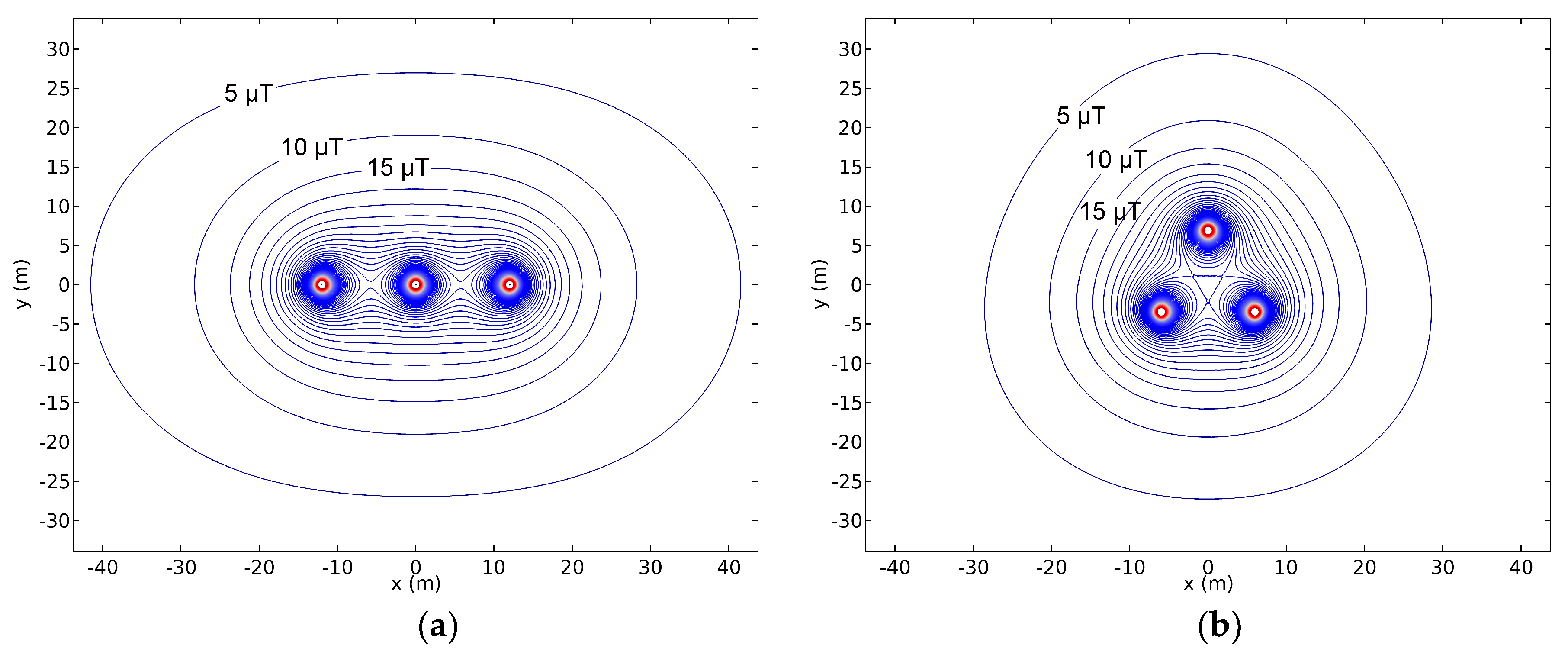
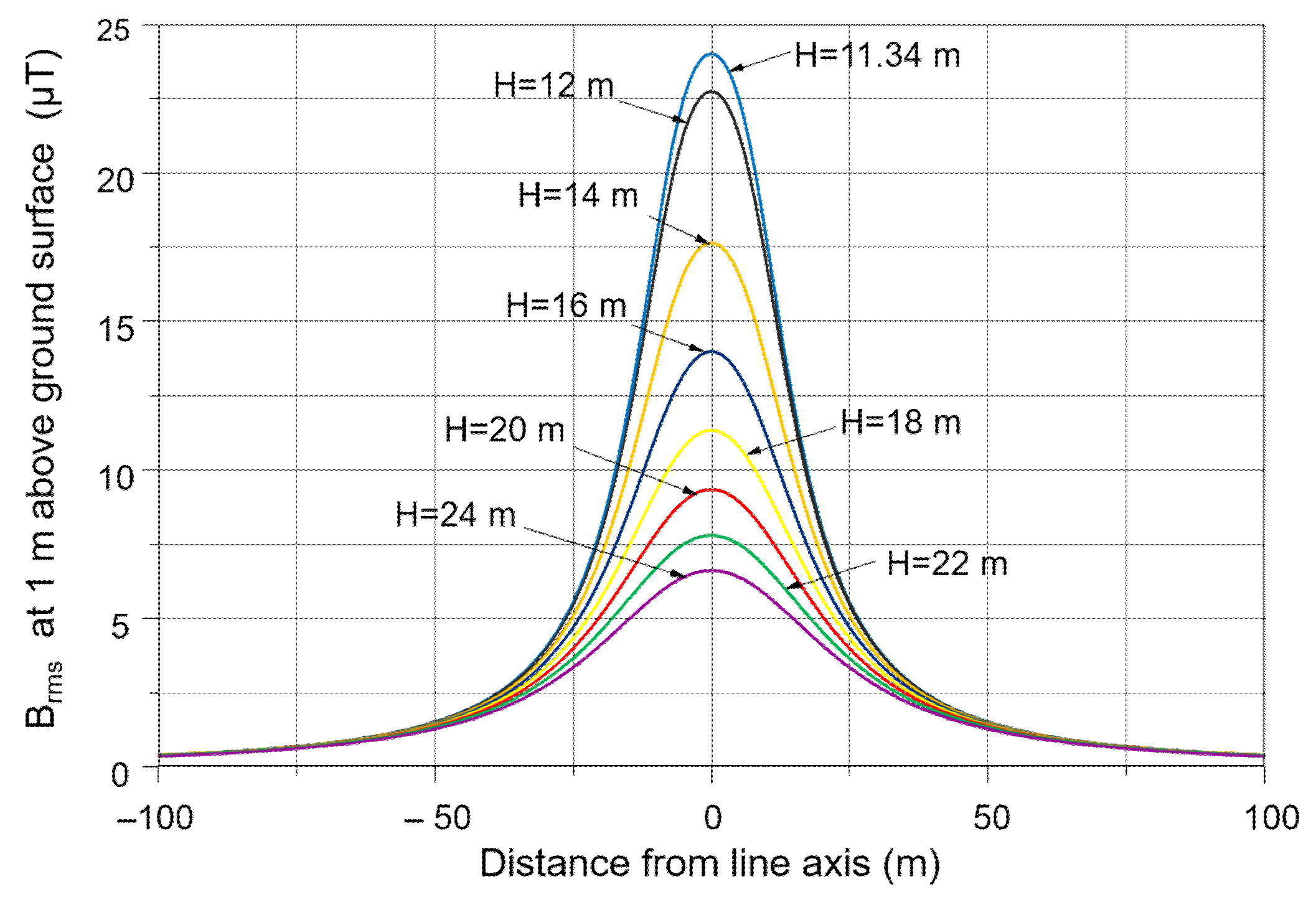
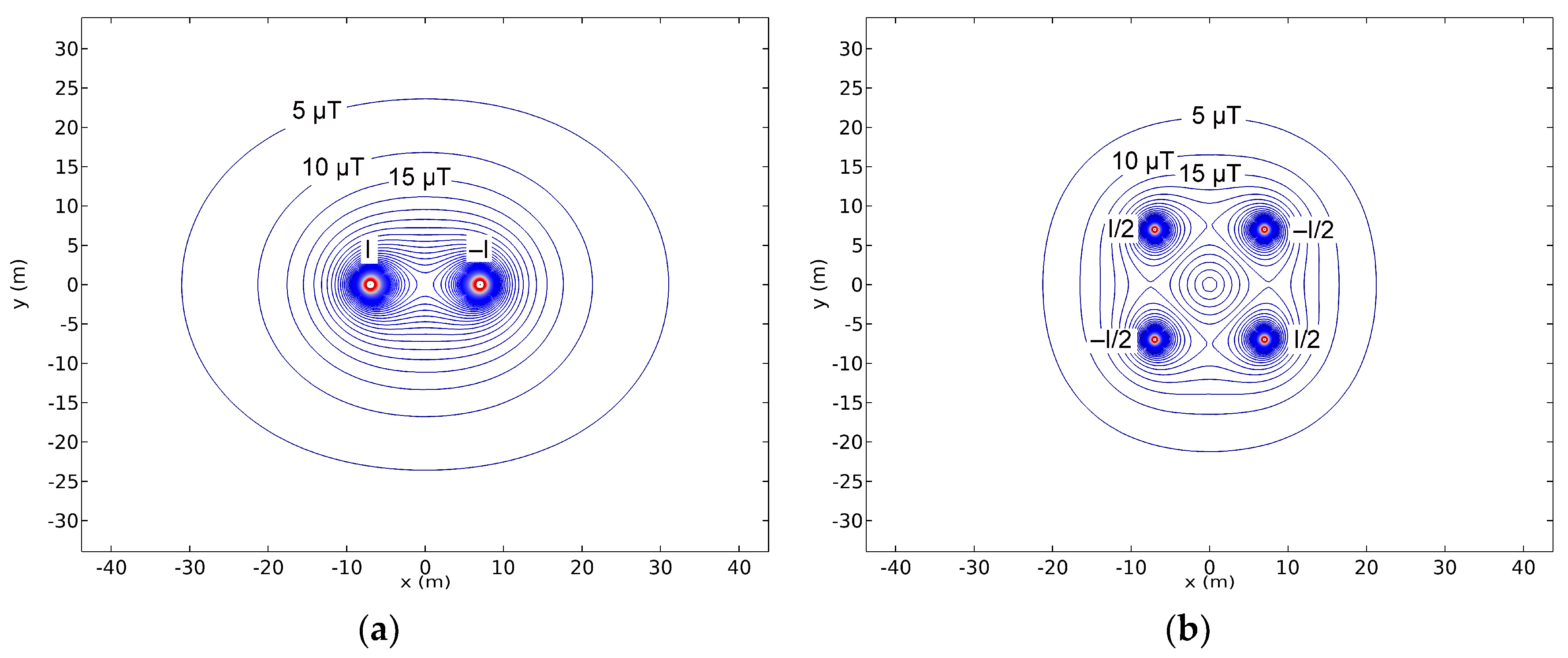
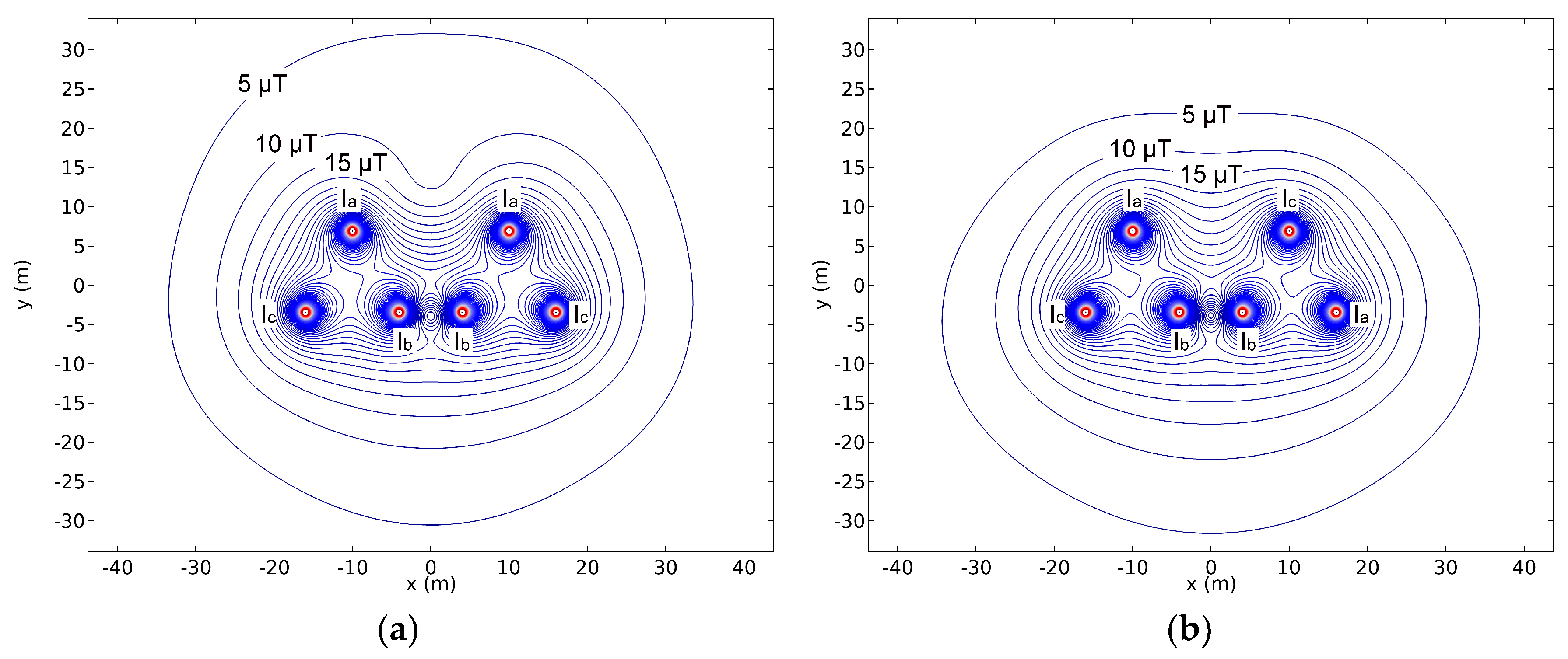




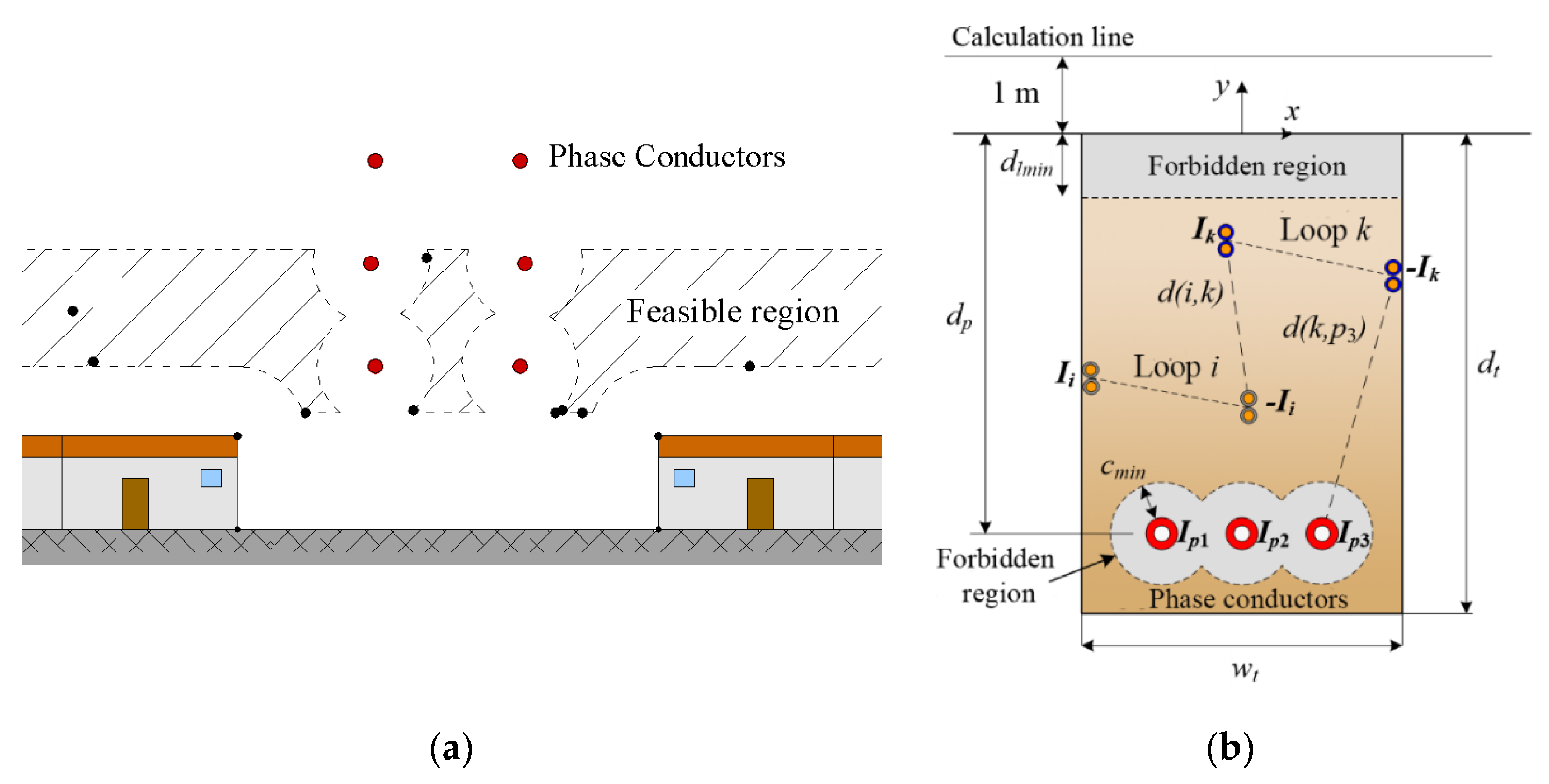


| Scope | ICNIRP 2010 [7] | IEEE 2002 [8] |
|---|---|---|
| General public | 200 | 904 |
| Occupational | 1000 | 2710 |
| MF Mitigation Method | Years | Optimization Technique | MF Mitigation Applications | ||
|---|---|---|---|---|---|
| 1990s | 2000s | 2010s | |||
| Conductor arrangement | Parametric analysis | OHL/UPC | |||
| Multi-objective OPF | OHL | ||||
| Genetic Algorithm | OHL/UPC | ||||
| Particle Swarm Optimization | OHL | ||||
| Statistical approach | UPC | ||||
| Differential Evolution | OHL | ||||
| Passive loops | Parametric Analysis | OHL/UPC/Subst. | |||
| Augmented Lagrangian | OHL | ||||
| Genetic Algorithm | OHL/UPC | ||||
| Particle Swarm Optimization | OHL | ||||
| Active loops | Parametric analysis | OHL/UPC/Subst. | |||
| Annealing optimization | OHL | ||||
| Genetic Algorithm | OHL/UPC/Subst. | ||||
| Multiagent Swarm Stochastic | OHL | ||||
| Passive shields | Parametric analysis | OHL/UPC/Subst. | |||
| Continuum Gradient | UPC | ||||
| Genetic Algorithm | UPC | ||||
© 2019 by the authors. Licensee MDPI, Basel, Switzerland. This article is an open access article distributed under the terms and conditions of the Creative Commons Attribution (CC BY) license (http://creativecommons.org/licenses/by/4.0/).
Share and Cite
Bravo-Rodríguez, J.C.; del-Pino-López, J.C.; Cruz-Romero, P. A Survey on Optimization Techniques Applied to Magnetic Field Mitigation in Power Systems. Energies 2019, 12, 1332. https://doi.org/10.3390/en12071332
Bravo-Rodríguez JC, del-Pino-López JC, Cruz-Romero P. A Survey on Optimization Techniques Applied to Magnetic Field Mitigation in Power Systems. Energies. 2019; 12(7):1332. https://doi.org/10.3390/en12071332
Chicago/Turabian StyleBravo-Rodríguez, Juan Carlos, Juan Carlos del-Pino-López, and Pedro Cruz-Romero. 2019. "A Survey on Optimization Techniques Applied to Magnetic Field Mitigation in Power Systems" Energies 12, no. 7: 1332. https://doi.org/10.3390/en12071332





